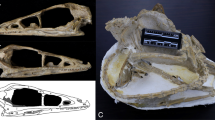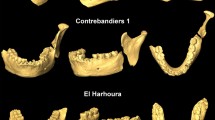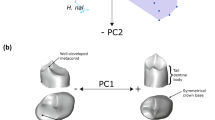Abstract
Just over 60 years ago, Dart's description and analysis of the Taung child's skull1 triggered an intellectual revolution about human origins. Recently, several authors have suggested that one of the most significant hominid-like traits of australopithecines, delayed maturation, may not after all be valid2–4. This is a radical departure from Mann's5 classic study of australopithecine maturation and palaeodemography based on dental eruption patterns. The resolution of this debate has important implications for the history of the biological and social evolution of the human species. In view of the controversies generated by recent studies6, and particularly because the Taung skull is the type specimen of Australopithecus africanus, we have investigated the relevant anatomy of the Taung 'child' using computerized tomography. We conclude that the Taung 'child' shows some important dental maturational affinities with great apes, although as Dart1 noted, other hominid-like features are clearly present.
This is a preview of subscription content, access via your institution
Access options
Subscribe to this journal
Receive 51 print issues and online access
$199.00 per year
only $3.90 per issue
Buy this article
- Purchase on Springer Link
- Instant access to full article PDF
Prices may be subject to local taxes which are calculated during checkout
Similar content being viewed by others
References
Dart, R. A. Nature 115, 195–199 (1925).
Bromage, T. G. in Hominid Evolution: Past, Present and Future (ed. Tobias, P. V.) 239–246 (Liss, New York, 1985).
Bromage, T. G. & Dean, M. C. Nature 317, 525–527 (1985).
Smith, B. H. Nature 323, 327–330 (1986).
Mann, A. E. Palaeodemographic Aspects of the South African Australopithecines (University of Pennsylvania, Philadelphia, 1975).
Lewin, R. Science 235, 748–750 (1987).
Skinner, M. F. & Sperber, G. H. Atlas of Radiographs of Early Man (Liss, New York, 1982).
Conroy, G. C. & Vannier, M. W. Science 226, 456–458 (1984).
Conroy, G. C. & Vannier, M. W. in Hominid Evolution: Past, Present and Future (ed. Tobias, P. V.) 419–426 (Liss, New York, 1985).
Conroy, G. C. & Vannier, M. W. in Proc. 10th Congr. Int. Primatol Soc. Vol. 1 (eds Else, J. & Lee, P.) 212–222 (Cambridge University Press, 1986).
Zonneveld, F. W. & Wind, J. in Hominid Evolution: Past, Present and Future (ed. Tobias, P.) 427–436 (Liss, New York, 1985).
Dean, M. C. Am. J. phys. Anthrop 67, 251–258 (1985).
Wallace, J. A. thesis Univ. Witwatersrand (1972).
Dean, M. C. & Wood, B. A. Folia Primatol. 36, 111–127 (1981).
Swindler, D. R. in Nonhuman Primate Models for Human Growth and Development, 69–86 (Liss, New York, 1985).
Van der Linden, F. P. G. M. & Duterloo, H. S. Development of the Human Dentition: an Atlas (Harper and Row, New York, 1976).
Gustafson, G. & Koch, G. Odont. Rev. 25, 297–306 (1974).
Moorrees, C. F. A., Fanning, E. A. & Hunt, E. E. J. dent. Res. 42, 1490–1502 (1963).
Schour, I. & Massler, M. J. am. dent. Ass. 28, 1153–1160 (1941).
Broom, R. & Robinson, J. T. Nature 167, 443 (1951).
Broom, R. & Robinson, J. T. Transv. Mus. Mem. 6, 1–123 (1952).
Grine, F. E. Am. J. phys. Anthrop. 72, 353–360 (1987).
Beynon, A. D. & Wood, B. A. Nature 326, 493–496 (1987).
Smith, H. B. & Garn, S. M. Am. J. phys. Anthrop. (in the press).
Schultz, A. H. Am. J. phys. Anthrop. 19, 489–581 (1935).
Schultz, A. H. Contr. Embryol. 28, 1–63 (1940).
Moss-Salentijn, L. in Surgery of the Paranasal Sinuses (eds Biitzer, A., Lawson, W. & Friedman, W. H.) 1–22 (Saunders, Philadelphia, 1985).
Ritter, F. N. The Paranasal Sinuses (Mosby, St Louis, 1978).
Odita, J. C., Akamaguna, A. I., Ogisi, F. O., Amu, O. D. & Ugbodaga, C. I. Pediatr. Radiol. 16, 365–367 (1986).
Cave, A. J. E. & Haines, R. W. J. Anat. 74, 493–523 (1940).
Tobias, P. V. Olduvai Gorge Vol. 2 (Cambridge University Press, 1967).
Broom, R. & Schepers, G. W. H. Transv. Mus. Mem. 2, 1–272 (1946).
Author information
Authors and Affiliations
Rights and permissions
About this article
Cite this article
Conroy, G., Vannier, M. Dental development of the Taung skull from computerized tomography. Nature 329, 625–627 (1987). https://doi.org/10.1038/329625a0
Received:
Accepted:
Issue Date:
DOI: https://doi.org/10.1038/329625a0
This article is cited by
-
Life-History Inference in the Early Hominins Australopithecus and Paranthropus
International Journal of Primatology (2012)
-
Evolutionary Development in Australopithecus africanus
Evolutionary Biology (2012)
-
Generalized individual dental age stages for fossil and extant placental mammals
Paläontologische Zeitschrift (2011)
-
Determination of gender by measuring the size of the maxillary sinuses in computerized tomography scans
Surgical and Radiologic Anatomy (2007)
Comments
By submitting a comment you agree to abide by our Terms and Community Guidelines. If you find something abusive or that does not comply with our terms or guidelines please flag it as inappropriate.



